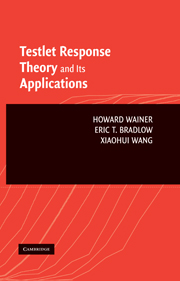PART III - TWO APPLICATIONS AND A TUTORIAL
Published online by Cambridge University Press: 08 January 2010
Summary
Thus far we have developed and discussed the machinery for models that can properly score tests that are made up of testlets. These models, especially the Bayesian ones discussed in Part II, are very general and hence there are many ways that they can be useful in the myriad situations that modern testing presents. Most standard test models nest within the general framework we have constructed. Traditional item response theory (IRT) emerges if all testlets contain but a single item; traditional true score theory devolves by treating a test as being made up of only one large testlet. In this part, we describe two special applications of these models as well as provide a tutorial on Bayesian estimation in general and MCMC methods in particular.
In Chapter 13, we examine the problem of measuring the efficacy of a test when there is a cut score. Traditional measures of reliability are incomplete, since they focus on the stability of the overall ordering of the examinees and not on the stability of the classification of examinees into classes of “passers” and “failers.” We use this problem to illustrate how the posterior distribution of proficiency allows us to easily construct curves (posterior probability of passing or PPoP curves) that answer this question directly.
Chapter 14 deals with the differential performance of items and testlets in different examinee subgroups. Detecting and measuring differential performance has a rich history – both for items (differential item functioning, DIF) and for testlets (differential testlet functioning, DTF). In this chapter, we discuss how a Bayesian approach to this provides us with an answer that is more robust than the Mantel–Haenszel method for extreme circumstances.
- Type
- Chapter
- Information
- Testlet Response Theory and Its Applications , pp. 205 - 206Publisher: Cambridge University PressPrint publication year: 2007



